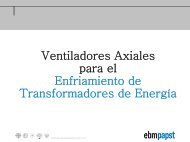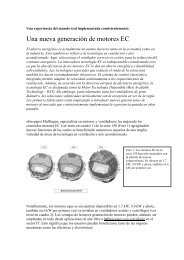Download [PDF] 2.3 MB - ebm-papst UK
Download [PDF] 2.3 MB - ebm-papst UK
Download [PDF] 2.3 MB - ebm-papst UK
You also want an ePaper? Increase the reach of your titles
YUMPU automatically turns print PDFs into web optimized ePapers that Google loves.
GREENTECH EC MOTORSFigure 2 (left): EC motors have a significantlyhigher efficiency than comparableasynchronous motors.LEGENDEfficiency [%]EC motorThree-phase asynchronous motorAC capacitor motorShaded-pole motorShaft power [W]Figure 3 (right): Cutaway drawing ofcentrifugal fan with external rotor motor– the rotor rotates not in, but about thestator.The rotor is on the outside At this kind of motor,the still-standing part, the stator, is located onthe inside and is surrounded by the rotating part,the rotor (Figure 3). The externally positioned rotorrotates about the internal stator. Conditionedby this arrangement, the external rotor motor canachieve a higher torque (magnet volume, air gapsurface, radius) than the internal rotor motor ofthe same package length, the same magnet systemand the same magnet thickness (reducedmagnet volume, reduced air gap surface, smallerradius). By cleverly using the design parametersin the fan and blower area, an external rotor motorusing hard ferrite magnets can attain torquesand efficiencies which the internal rotor motorcan achieve only with rare earth magnets (becauseof the limited volume and mass). Unlikeservo drives, fans do not require high dynamics.Quite the opposite is required: a certain momentof inertia is desirable for the fans to have smoothstarting and acceleration behaviour. Without restrictionsrare earth magnets can be given up andferrite magnets can be used, which are not onlysignificantly more cost-effective, but also havestable market prices due to their availability.The motor design with an external rotor is advantageousfor fans in another regard as well.This way, the axial or centrifugal impellers can bemounted on the rotating rotor, thus directly on the“housing” of the motor (Figure 4). Compact dimensions,especially in an axial direction, are theconsequence and cooling is made simpler as themoved air of the fan is also cooling the motorhousing. The design with sinusoidal commutationalso provides for particularly low-noise operation.The energy-efficient GreenTech EC fans are thereforecompletely independent of the market trendof rare earth magnets.Figure 4: Energy-efficient fans whosemotors make do without rare earthmagnets.Authors are Dr. Jürgen Schöne, R&D Director of Aerodynamics and Motortechnology(left) and Werner Müller, Department Manager of Motor Development(right) at <strong>ebm</strong>-<strong>papst</strong> MulfingenYou would like more information on this topic? Please address your question to:Juergen.Schoene@de.<strong>ebm</strong><strong>papst</strong>.com or Werner.Mueller@de.<strong>ebm</strong><strong>papst</strong>.comtechmag 01°201319


![Download [PDF] 2.3 MB - ebm-papst UK](https://img.yumpu.com/52907850/19/500x640/download-pdf-23-mb-ebm-papst-uk.jpg)



![[PDF] 22.3 MB - ebm-papst Argentina](https://img.yumpu.com/7645467/1/184x260/pdf-223-mb-ebm-papst-argentina.jpg?quality=85)